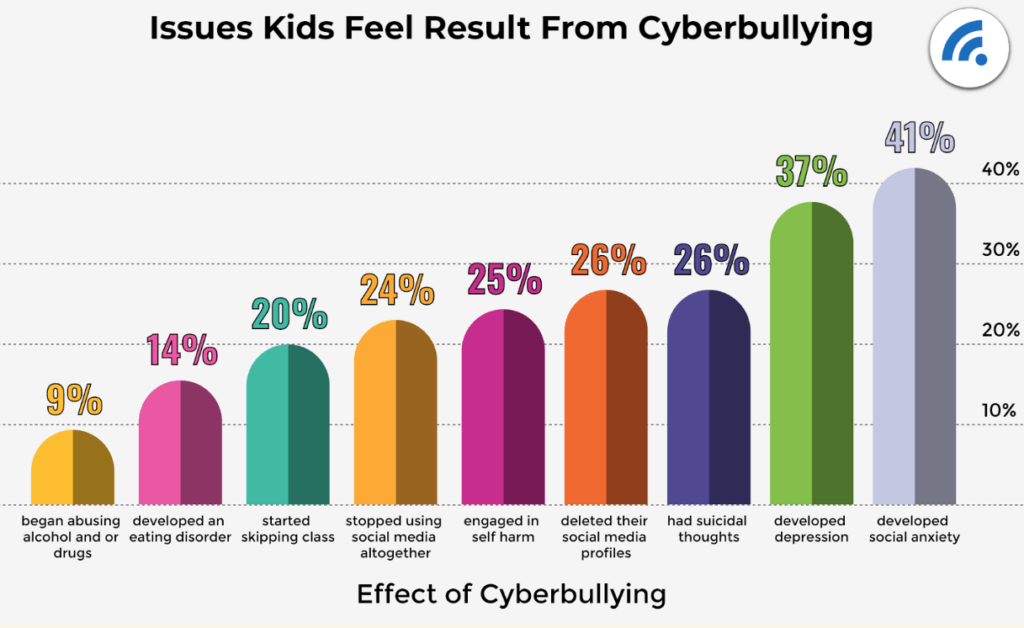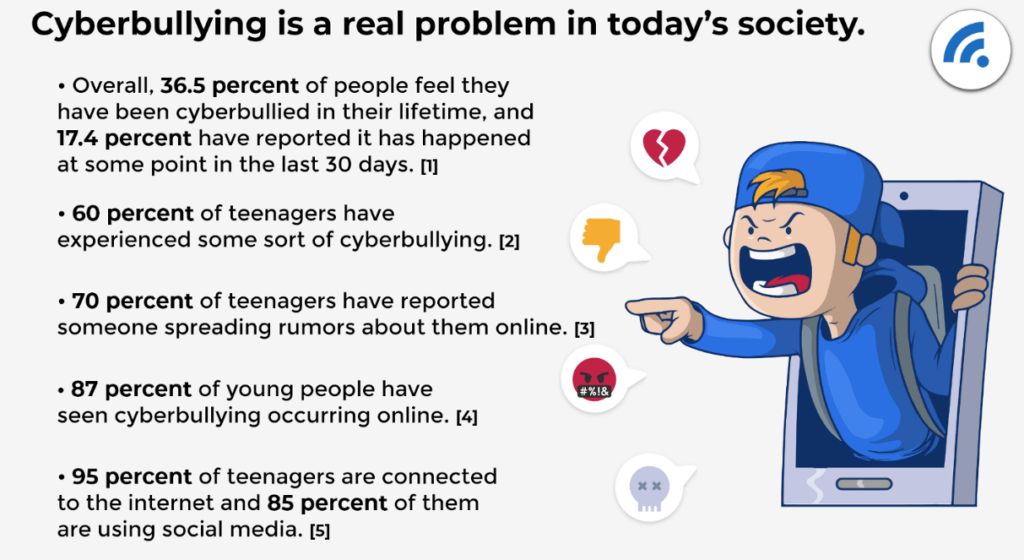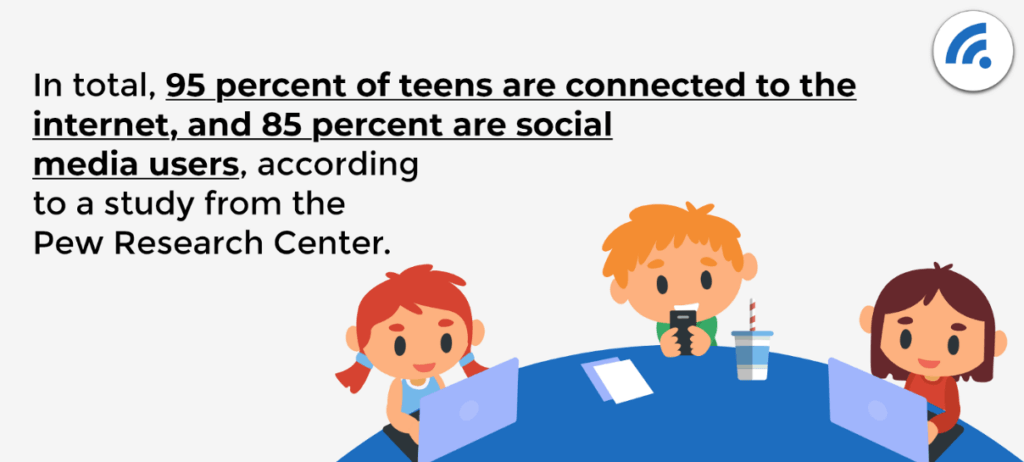
For the third year in a row, we at Extra Inning softball are focusing on the issue of cyberbullying, which statistics show continues to be a big problem, especially for teens.
Previously, we’ve run these articles:
- Topical Issue: Cyberbullying… What Is It? And How Do We Stop It? (2021)
- Topical Issue: Bullying & Cyberbullying… the Stats Show It’s a National Plague, Especially for Teens (2020)
This problem impacts us at Extra Inning in two ways:
- we are an online-focused site and the cyberworld is where so many live today,
- much of our market focuses on and consists of student-athletes—including high school and college-aged softball players—who are often involved in bullying… be it in-person or online.
 Personally, as a parent of teenagers, I witness (often, without them knowing it) the conversations and interactions that happen online. I see and hear the joking and teasing; occasionally, I even observe what would be considered cyberbullying. And I’m very quick to point out behavior that is not appropriate or acceptable in any way.
Personally, as a parent of teenagers, I witness (often, without them knowing it) the conversations and interactions that happen online. I see and hear the joking and teasing; occasionally, I even observe what would be considered cyberbullying. And I’m very quick to point out behavior that is not appropriate or acceptable in any way.
Unfortunately, as I talk to coaches across the nation, I hear about bullying being an issue everywhere and—sad to say—some athletes have been downgraded in our rankings because of how they’ve been proven to have treated others. After all, if you can’t get along now with your teammates, it’s likely not going to get better in the future.
As the latest sobering report indicates, teens—including student-athletes—are online more than ever meaning those exposed to this behavior are also higher:
… 60% of teens have said they’ve been bullied online and an astounding 87% report they’ve witnessed it online.
And, tragically, we’ve had to report on suicides of young athletes who felt bullied to the point where they saw no way out of their pain otherwise.
Please take a few minutes to read the information, let it soak in and become aware of the signs and symptoms of those who may feel bullied themselves. And for information, click HERE to go to the BroadBandSearch.net site which gave us permission to run their research on this growing social media pandemic…
— Brentt Eads, Extra Inning Softball
*****
As the world becomes more and more digital, our lives are also becoming more digital. The Coronavirus pandemic has meant we conduct more and more of our daily existences over the internet than ever before.
In general, this is a good thing. Digital technologies make our lives easier, and they also facilitate business, communication, government, and much more. However, as is the case with most things, with the good also comes the bad, and one of those negatives to come from all this internet use is cyberbullying.

What is Cyberbullying?
As the name suggests, cyberbullying is bullying in a digital space, such as on phones, computers, tablets, etc., in arenas such as text messaging, social media, forums, online gaming, and more.
Even in 2022, bullying is still a problem for most people. 73 percent of students feel they have been bullied in their lifetime, and 44 percent say it’s happened in the last 30 days.
It should come as no surprise that cyberbullying has become such an issue. All that has really happened is that an age-old problem has made its way into the digital world.
One could argue that cyberbullying is more damaging than traditional in-person bullying because it can happen at any moment during any day. The words people use to bully are out there in the digital space, and so cyberbullying is more difficult to spot, meaning it often goes unnoticed.
To see how big of a problem this is, here are all the stats about cyberbullying that you need to know:
Cyberbullying in 2022
Cyberbullying is a real problem in today’s society. Consider that:

An Imminent Threat
These numbers show that cyberbullying is not some tiny problem experienced by just a select few individuals but instead is a widespread issue in society. Therefore, we all must understand what cyberbullying is, why it happens, how to stop it, and how to help victims.
It’s Not Just Children
Although a lot of the cyberbullying focus is on kids, mainly because this group is most vulnerable to the long-term impacts of cyberbullying, they are not the only victims.
Adults are often guilty of or subjected to cyberbullying. However, cyberbullying is often called something else when done to adults, such as harassment or sometimes even stalking.
To give you an idea of how prevalent these problems are, sixteen percent of women and one in 19 men have been stalked at some point in their lifetime. Four in ten Americans have experienced some form of online harassment.
Also, consider that:
- In Australia, around ten percent of adults admit to having been victims of cyberbullying. [The Sunday Morning Herald]
- In the U.S., 40 percent of adults have personally experienced some form of online harassment, and 75 percent of adults have seen cyberbullying occurring around them. [Pew Research Center]
These numbers are troubling. They show that cyberbullying is pervasive and doesn’t go away as we get older.
Perhaps what they highlight the most is that our global society needs more than anything is to learn how to be nice to one another.
More Cyberbullying Statistics Everyone Should Know
At this point, it should be clear that cyberbullying is a significant problem in today’s society. But where does cyberbullying occur?
To get a little bit deeper into the problems cyberbullying causes, take a look at the following data provided by Ditch the Label, one of the world’s leading anti-bullying organizations.
They asked students to indicate on which social media platforms they had experienced cyberbullying, and here are the results:

The study also revealed some surprising statistics about the number of people that are perpetrators of cyberbullying. For example, they found that:
- 69 percent of people report having done something abusive towards others online.
- 15 percent of people admit to having cyberbullied someone else online.
These statistics are troubling because it suggests a general misunderstanding of precisely what cyberbullying is.
More specifically, it’s likely these people who have admitted to doing something abusive towards others online actually engaged in cyberbullying. Still, because of a lack of awareness about this, they do not admit it.
Here are some more cyberbullying statistics to consider:
- Over half of students who identify as being LGBTQ have experienced cyberbullying at some point. [StopBullying.gov]
- Girls are more likely to be a victim of cyberbullying than boys. Overall, around 36 percent of girls have reported being cyberbullied compared to 26 percent of boys. [Pew Research Center]
- 83 percent of those who have been cyberbullied have also been bullied in person, and 69 percent of those who admitted to bullying online have also admitted to in-person bullying. [Florida Atlantic University]

Why Are People Cyberbullied?
To tackle the problem of bullying and cyberbullying, it’s important to look at why people are cyberbullied. The graph below shows us some of the main reasons why people get attacked online:

The Impacts of Cyberbullying
Even if you’ve been fortunate enough to escape cyberbullying, this doesn’t mean you don’t need to worry about it.
The effects of cyberbullying can have a tremendously negative impact on the mental health and well-being of victims. These impacts are far more severe than just “feeling bad” about yourself. They go deeper and touch more sensitive parts of the human psyche.
Victims can feel these effects in both the short and long term, and they help point out why we should be taking cyberbullying so seriously.
Here is a rundown of some of the more troubling statistics about the impact of cyberbullying:
- 64 percent of people who have been cyberbullied say it affects their ability to learn and feel safe at school. [Cyberbullying Research Center]
- Students who experience cyberbullying are more likely to have trouble adjusting to school. They are also more likely to have mental health and behavior problems. [Center for Disease Control]
- Bullied students are twice as likely as other students to experience problems such as headaches and stomach aches. [Gini and Pozzoli, 2013]
- 19 percent of bullied students say the experience has negatively impacted how they feel about themselves. 14 percent say it has negatively impacted their relationships with friends and family, and 9 percent reported a negative impact on their schoolwork. [National Center for Education Statistics]
What’s perhaps more concerning, though, is the impact cyberbullying has on the one doing the actual bullying.
According to a study published in The Journal of Early Adolescence, cyberbullying can actually help improve a student’s perceived popularity.
This suggests that we as a society encourage this type of behavior by rewarding those who engage in it with higher social standing.
The Results of Cyberbullying
Below are some of the other impacts that students have reported as having resulted from cyberbullying:
- 25 percent of teens have had an online bullying experience that culminated in a face-to-face confrontation.
- 13 percent reported cyberbullying made them concerned about going to school the next day.
- 8 percent reported having physical altercations with someone because of something that occurred on a social network site.
- 6 percent reported another student sending an instant message or chat to hurt their feelings.
- 4 percent reported having something put on a profile page to hurt their feelings.
- 3 percent reported receiving a nasty email from another student.
Mental Health Problems Stemming From Cyberbullying
To help you get a better idea about some of the impacts cyberbullying can have on mental health, consider the following findings from the Ditch the Label study.
In this survey, students who had been cyberbullied were asked to identify what issues they felt arose because of their cyberbullying experience. The results were:

How Can You Tell If Someone Is Being Cyberbullied?
Knowing the detrimental effects of cyberbullying, and also that people who suffer from it are unlikely to say anything about it, you must know the signs someone is suffering so that you can step in and be the helping hand which they are often too shy or embarrassed to ask for.
According to the National Crime Prevention Center (NCPC), there are several behavioral changes that someone being cyberbullied may undergo. For example, they may:
- Become shy and withdrawn
- Be moody, agitated, anxious, or stressed out
- Act more aggressively towards others
- Protest more about going to school
- Get into trouble at school
- Skip school
- Experience a dip in academic performance
- **Stop using the computer or other devices that connect to the internet**
- Change eating and sleeping habits. For example, they may begin experiencing nightmares
- Attempt self-harm or threaten suicide
- Suddenly start hanging out with a new group of friends
**This is considered one of the biggest red flags, mainly because kids are connected to their devices. If you notice a significant change, then it’s crucial to speak to them to find out what they are experiencing.**
Recognizing Cyberbullies
On the other side of things, it’s essential to look out for some of the signs that someone is engaging in cyberbullying.
As shown by the statistics, more people engage in cyberbullying than you might think, and these numbers are based on those who admit it. There may be more people than the research suggests.
It’s tricky to determine when someone is engaging in cyberbullying, but it’s not impossible. Typically, children, or adults, who are engaging in cyberbullying will:
- Stop using their computer or phone when someone comes near them
- Look nervous or jumpy when online
- Be secretive about what they are doing online
- Spend an excessive amount of time on the computer
- Become angry or upset when internet privileges are taken away (this is more the case with children than adults)
If you see anyone exhibiting these types of behaviors, then consider investigating more and intervening where possible.
What Should You Do If You Believe Someone is a Victim of Cyberbullying?
As of 2021, around 81 percent of kids think that bullying is easier to get away with online. Part of the reason for this could be that 90 percent of kids who see cyberbullying ignore it.
However, 84 percent of students report having seen someone stand up to a cyberbully to tell them to stop what they are doing.
This suggests that only a small group of people speak up about cyberbullying, which needs to change.
As an adult, if you see a kid being cyberbullied, consider doing one of the following:
- Ask your child to go over their list of contacts in their phone and instant messaging apps so that you can know more about the people with whom they communicate.
- Talk to your kids about cyberbullying so that they know what it is and how to understand when it is happening.
- Emphasize to kids that they will not lose internet privileges if they are being cyberbullied. Believe it or not, this is the main reason kids choose not to speak up about cyberbullying, according to the NCPC.
- Raise the issue with teachers and school administrators so they can look for signs of bullying in school and address the problem in the best way possible.
- Reach out to your child’s friends. An engaging bystander is a key component of fighting bullying, so those who must witness the abuse know what they are seeing and how to react.
Those being cyberbullied have options, too. Ensure kids know this by going over what they should be doing if they feel they are a victim. Some things you can do if you feel you’re being cyberbullied are:
- Tell someone you trust about what’s going on so that you can get some help.
- Keep emails, texts, comments, etc., that could serve as evidence of cyberbullying.
- Don’t strike back. Two wrongs don’t make a right.
- Report the issue to the website. For example, Facebook and YouTube both have places where you can report cyberbullying in a safe environment.
Conclusion
As you can see, cyberbullying is a significant issue in societies worldwide, and it isn’t something that only kids have to deal with. Everyone has to face these challenges.
Hopefully, these stats have helped you see how serious this problem is and your role in addressing it. Keep an eye out in your digital communities, and if you see someone acting towards someone else in a harmful way, say something. You might just save their life.





